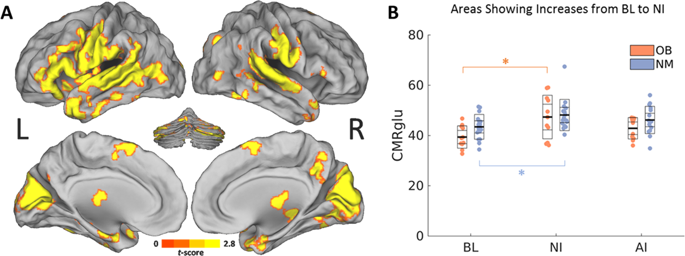当前位置:
X-MOL 学术
›
Int. J. Obesity
›
论文详情
Our official English website, www.x-mol.net, welcomes your
feedback! (Note: you will need to create a separate account there.)
Inhibition of food craving is a metabolically active process in the brain in obese men.
International Journal of Obesity ( IF 4.2 ) Pub Date : 2019-11-18 , DOI: 10.1038/s41366-019-0484-z Gene-Jack Wang 1 , Ehsan Shokri Kojori 1 , Kai Yuan 1, 2 , Corinde E Wiers 1 , Peter Manza 1 , Christopher T Wong 1 , Joanna S Fowler 3 , Nora D Volkow 1, 4
International Journal of Obesity ( IF 4.2 ) Pub Date : 2019-11-18 , DOI: 10.1038/s41366-019-0484-z Gene-Jack Wang 1 , Ehsan Shokri Kojori 1 , Kai Yuan 1, 2 , Corinde E Wiers 1 , Peter Manza 1 , Christopher T Wong 1 , Joanna S Fowler 3 , Nora D Volkow 1, 4
Affiliation

|
OBJECTIVE
Obesity is associated with impaired inhibitory control over food intake. We hypothesized that the neural circuitry underlying inhibition of food craving would be impaired in obesity. Here we assessed whether obese men show altered brain responses during attempted cognitive inhibition of craving when exposed to food cues.
METHODS
Sixteen obese men (32 ± 8.7 years old, BMI = 38.6 ± 7.2) were compared with 11 age-matched non-obese men (BMI 24.2 ± 2.5) using PET and FDG. Brain glucose metabolism was evaluated in a food deprived state: no food stimulation, food stimulation with no inhibition (NI), and food stimulation with attempted inhibition (AI), each on a separate day. Individualized favorite food items were presented prior to and after FDG injection for 40 min. For AI, participants were asked to attempt to inhibit their desire for the food presented. Self-reports for hunger and food desire were recorded.
RESULTS
Food stimulation compared with no stimulation increased glucose metabolism in inferior and superior frontal gyrus, default mode network and cerebellum, in both groups. For both groups, AI compared with NI-suppressed metabolism in right subgenual anterior cingulate, orbitofrontal areas, bilateral insula, and temporal gyri. There was a stimulation-by-group interaction effect in obese (but not in non-obese) men showing increased metabolism in pregenual anterior cingulate cortex (pgACC) and caudate during AI relative to NI. Changes in the food desire from NI to AI correlated negatively with changes in metabolism in pgACC/caudate in obese but not in non-obese men.
CONCLUSIONS
Obese men showed higher activation in pgACC/caudate, which are regions involved with self-regulation and emotion/reward during AI. Behavioral associations suggest that successful AI is an active process requiring more energy in obese but not in non-obese men. The additional required effort to increase cognitive control in response to food stimulation in obese compared with non-obese men may contribute to their uncontrolled eating behavior.
中文翻译:

抑制食物渴望是肥胖男性大脑中的代谢活跃过程。
目的肥胖与对食物摄入的抑制控制减弱有关。我们假设肥胖中潜在的抑制食物渴望的神经回路会受到损害。在这里,我们评估了肥胖男性在暴露于食物线索时,是否在尝试抑制认知渴望的过程中是否表现出改变的大脑反应。方法采用PET和FDG技术对16名肥胖男性(32±8.7岁,BMI = 38.6±7.2)与11名年龄相匹配的非肥胖男性(BMI 24.2±2.5)进行比较。在禁食状态下评估大脑的葡萄糖代谢:无食物刺激,无抑制作用的食物刺激(NI)和无抑制作用的食物刺激(AI),分别在单独的一天进行。在FDG注射之前和之后40分钟展示个性化的喜爱食品。对于AI 要求参与者试图抑制他们对所提供食物的渴望。记录了饥饿和食物欲望的自我报告。结果在两组中,食物刺激与未刺激相比均增加了下额和上额回,默认模式网络和小脑的葡萄糖代谢。对于两组,在右下颌前扣带,眶额区,双侧岛突和颞回中,AI均与NI抑制的代谢相比。相对于NI,肥胖(而非肥胖)男性的按组刺激相互作用表现为先天的前扣带回皮层(pgACC)和尾状体的新陈代谢增加。从NI到AI的食物需求变化与肥胖男性(而非肥胖男性)的pgACC /尾状体的新陈代谢变化呈负相关。结论肥胖男性在pgACC /尾状核中具有较高的激活率,而pgACC /尾状核是AI期间涉及自我调节和情绪/奖赏的区域。行为联想表明,成功的AI是一个活跃的过程,肥胖者需要更多的精力,而非肥胖者则不需要。与非肥胖男性相比,增加额外的努力来增加肥胖者对食物刺激的认知控制,可能会导致他们的饮食行为不受控制。
更新日期:2019-11-18
中文翻译:

抑制食物渴望是肥胖男性大脑中的代谢活跃过程。
目的肥胖与对食物摄入的抑制控制减弱有关。我们假设肥胖中潜在的抑制食物渴望的神经回路会受到损害。在这里,我们评估了肥胖男性在暴露于食物线索时,是否在尝试抑制认知渴望的过程中是否表现出改变的大脑反应。方法采用PET和FDG技术对16名肥胖男性(32±8.7岁,BMI = 38.6±7.2)与11名年龄相匹配的非肥胖男性(BMI 24.2±2.5)进行比较。在禁食状态下评估大脑的葡萄糖代谢:无食物刺激,无抑制作用的食物刺激(NI)和无抑制作用的食物刺激(AI),分别在单独的一天进行。在FDG注射之前和之后40分钟展示个性化的喜爱食品。对于AI 要求参与者试图抑制他们对所提供食物的渴望。记录了饥饿和食物欲望的自我报告。结果在两组中,食物刺激与未刺激相比均增加了下额和上额回,默认模式网络和小脑的葡萄糖代谢。对于两组,在右下颌前扣带,眶额区,双侧岛突和颞回中,AI均与NI抑制的代谢相比。相对于NI,肥胖(而非肥胖)男性的按组刺激相互作用表现为先天的前扣带回皮层(pgACC)和尾状体的新陈代谢增加。从NI到AI的食物需求变化与肥胖男性(而非肥胖男性)的pgACC /尾状体的新陈代谢变化呈负相关。结论肥胖男性在pgACC /尾状核中具有较高的激活率,而pgACC /尾状核是AI期间涉及自我调节和情绪/奖赏的区域。行为联想表明,成功的AI是一个活跃的过程,肥胖者需要更多的精力,而非肥胖者则不需要。与非肥胖男性相比,增加额外的努力来增加肥胖者对食物刺激的认知控制,可能会导致他们的饮食行为不受控制。











































 京公网安备 11010802027423号
京公网安备 11010802027423号